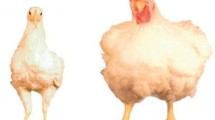Abstract
The report summarizes our four year experience with the breeding of squirrel monkeys, a New World species used widely in experimental research. Breeding squirrel monkeys in captivity has hitherto been considered capricious, with success in most instances not exceeding 50%. By a combination of hand picking the animals, housing in a harem-type situation with one male to several females, and sound nutrition, a success rate of 85–91% live births to number of pregnancies has been achieved. The rate of stillbirths and abortions in the group maintained on a well-balanced diet did not exceed 10% of the total pregnancies. This compares favorably with any successful breeding program with Old World monkeys, whose reproductive physiology is relatively well understood. It is clear from our studies that adequate quantities of proteins are essential for optimum reproduction. Among the pregnant animals maintained on a diet containing about 50% of their normal requirements of protein (8% calories from a protein source), the incidence of abortions increases significantly. In this group, the rate of abortions to total pregnancies ranges from 40.5 to 61.5%. The females maintained on a protein deficient diet during pregnancy are so protein hungry that an extruded fetus is a welcome food and no time is lost in devouring all of the placenta and the fetus. This type of cannibalism has never been observed among the mothers maintained on a high protein regimen.
Similar content being viewed by others
References
Bermant, G. &D. S. Lindburg, 1973. New concepts in primate production.J. Med. Primat., 2: 324–340.
Beveridge, W. I. B., 1972. Advantages of laboratory-bred monkeys over wild-caught animals: The use of non-human primates in research on human reproduction.WHO Symposium 1971, pp. 490–491.
Candland, K., D. S. Tyrell, D. S. Wagner, &N. M. Wagner, 1973. Social preference of the squirrel monkey (Saimiri sciureus).Folia primat., 19: 437–449.
Castellanos, H. &H. L. McCombs, 1968. The reproduction cycle of the New World monkey. Gynecologic problems in a breeding colony.Fertil. Steril., 19: 213–227.
Clarktson, T. B., B. C. Bullock, N. D. M. Lehner, &M. A. Feldner, 1969. The squirrel monkey as a laboratory animal. In:Animal Models for Biomedical Research, National Academy of Science, Washington, pp. 64–87.
Clewe, T. H., 1969. Observations on reproduction of squirrel monkeys in captivity.J. Reprod. Fertil. (Suppl. 6): 151–156.
Cooper, R. W., 1968. Squirrel monkey taxonomy and supply. In:The Squirrel Monkey,L. A. Rosenblum &R. W. Cooper (eds.), Academic Press, New York, pp. 1–29.
Delort, P., M. Chopard, &J. Tachon, 1976. The management of a squirrel monkey (Saimiri sciureus) unit.Lab. Anim. Sci., 26: 301–304.
Denniston, R. H., 1964. Notes on the vaginal cornification cycle of captive squirrel monkeys.J. Mammal., 45: 471.
DuMond, F. V. &T. C. Hutchinson, 1967. The squirrel monkey reproduction. The fatted male phenomenon and season spermatogenesis.Science, 158: 1467–1470.
Goss, C. M., L. T. Popejoy II, J. L. Fusiler, &T. M. Smith, 1968. Observations on the relationship between embryological development, time of conception, and gestation. In:The Squirrel Monkey,L. A. Rosenblum &R. W. Cooper (eds.), Academic Press, New York, pp. 171–191.
Harris, R. S., 1970.Feeding and Nutrition of Non-human Primates. Academic Press, New York, pp. 159–174.
Harrison, R. M. &R. W. Dukelow, 1973. Seasonal adaption of laboratory-maintained squirrel monkeys (Saimiri sciureus).J. Med. Primat., 2: 277–283.
Hayes, K. C., G. Fay, A. Roach, & F. J. Stare, 1972. Breeding New World monkeys in a laboratory environment. In:Breeding Primates, Karger, Basel, pp. 122–129.
Hupp, E. W., 1972. Reproduction in an indoor squirrel monkey colony. In:Internationaler Kongress für Tierische Fortpflanzung, Munchen, pp. 2313–2320.
Hutchinson, T. C., 1970. Vaginal cytology and reproduction in the squirrel monkey (Saimiri sciureus).Folia primat., 12: 212–223.
Institute of Laboratory Animal Resources, 1971. Survey of non-human primates being maintained 1 January, 1971.ILAR News, 15(1): 7–10.
————, 1972. ILAR questionnaire on animals used for research in 1970.ILAR News, 15(2): 1–9.
Jolly, A., 1972. Hour of birth in primates and man.Folia primat., 18: 108–121.
Kuehl, T. J. &W. R. Dukelow, 1975. Ovulation induction during the anovulatory season inSaimiri sciureus.J. Med. Primat., 4: 23–31.
Lang, C. M., 1967. The estrous cycle of the squirrel monkey (Saimiri sciureus).J. Lab. Anim. Care, 17: 442–451.
Lorenz, R., C. O. Anderson, &W. A. Mason, 1973. Notes on reproduction in captive squirrel monkeys (Saimiri sciureus).Folia primat., 19: 286–292.
Manocha, S. L., 1973. Experimental protein malnutrition in primates: Enzyme histochemical studies on the dorsal root ganglion cells of healthy and malnourished squirrel monkeys.Acta Histochem., 47: 220–232.
————, 1972. Cytochemistry of experimental protein malnutrition in primates: Effect on the spinal cord of squirrel monkeys.Histochem. J., 4: 531–544.
———— & ———— 1973. Experimental protein malnutrition in primates: Cytochemical studies on the cerebellum of squirrel monkeys (Saimiri sciureus).Histochem. J., 5: 105–118.
Nathan, T. S., L. A. Rosenblum, G. Limson, &J. H. Nelson, Jr., 1966. Diagnosis of pregnancy in the squirrel monkey.Anat. Rec., 155: 531–536.
Ploog, D. W., 1966. Biological basis for instinct and behavior: Studies on the development of social behavior in squirrel monkeys. In:Recent Advances in Biological Psychology, Vol. 8, Plenum Press, New York, pp. 199–223.
Rosenblum, L. A., 1972. Reproduction of squirrel monkeys in the laboratory. In:Breeding Primates, Karger, Basel, pp. 130–143.
————, 1968.The Squirrel Monkey. Academic Press, New York.
————, 1967. Vaginal cornification cycles in the squirrel monkey (Saimiri sciureus).Folia primat., 6: 83–91.
Schmidt, L. H., 1969. Breeding.Primates in Med., 2: 87–95.
Srivastava, P. K., F. Cavazos, &F. V. Lucas, 1970. Biology of reproduction in the squirrel monkey (Saimiri sciureus). I. The estrus cycle.Primates, 11: 125–134.
Symposium on the Breeding of Simians and Their Uses in Developmental Biology (London 3–5, June, 1974), 1975.J. Biol. Standardization, 3: 127–133.
Talmage-Riggs, G. &S. Anschel, 1973. Homosexual behavior and dominance hierarchy in a group of captive female squirrel monkeys (Saimiri sciureus).Folia primat., 19: 61–72.
Trollope, J. &N. G. Blurton-Jones, 1970. Breeding the stump-tailed macqueMacaca arctoides.Lab. Anim., 4: 161–169.
Author information
Authors and Affiliations
About this article
Cite this article
Manocha, S.L., Long, J. Experimental protein malnutrition during gestation and breeding performance of squirrel monkeys,Saimiri sciureus . Primates 18, 923–930 (1977). https://doi.org/10.1007/BF02382941
Received:
Accepted:
Issue Date:
DOI: https://doi.org/10.1007/BF02382941




